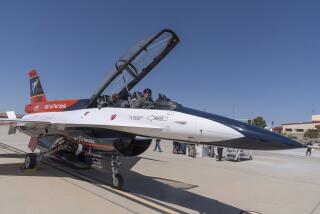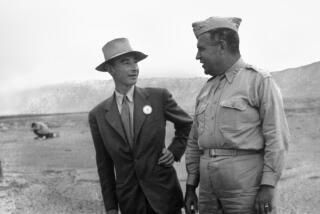Builder Bucks AF Over Plan to Protect Missiles
- Share via
After the government’s nuclear weapons experts had deliberated interminably over how to protect American missiles from a surprise Soviet attack, President Ronald Reagan took the unusual step in 1981 of asking the public for its ideas.
Paul Malzahn, owner of a construction firm in New Orleans, was no expert in nuclear missiles, but--based on his decades of experience in building reinforced concrete structures around the world--he came up with a novel and low-cost plan to defend the American weapons.
A neophyte in the ways of Washington, Malzahn began by simply writing a letter to Defense Secretary Caspar W. Weinberger on Oct. 16, 1981, asserting that he could build a system of subterranean walls that would isolate a missile silo from a nuclear blast.
That letter, Malzahn says, was the beginning of his undoing.
Alleges Patent Infringement
Eight years later, Malzahn’s effort has resulted in a patent infringement claim, in which he charges that the Air Force stole secret details of his concept from the U.S. Patent Office under the guise of national security and used them in awarding a $7-million contract to an aerospace firm to test the idea.
What Malzahn said he found during his odyssey into the defense world was an old boys’ network of military officials and their civilian counterparts at major aerospace firms who comprise the nation’s strategic brain trust.
It was not, he said, a fraternity ready to cooperate with the President’s call to the citizenry but was more concerned with protecting its own ideas and its longstanding cozy and lucrative relationships. Even after Congress voted funds in 1986, specifically to test Malzahn’s idea, the Air Force undercut his effort to win the test contract, he said.
“They told me I couldn’t get a contract because I wasn’t in the loop,” Malzahn recalled. “Like some kind of a dummy, I asked them, ‘How do you get into the loop?’ And they said: ‘If you were a big company doing work for us, then you’d be in the loop.’ ”
Ultimately, the test performed on Malzahn’s concept, known as a cofferdam, was botched, he charges. The cofferdam test structure was supposed to be sunk in the ground, but one-fourth of it was left sticking up into the air, Air Force officials acknowledged.
Nonetheless, those officials deny Malzahn’s sweeping allegations, saying that it dealt with him fairly and that his cofferdam would fail to protect a missile silo from all of the effects of a nuclear blast. Air Force officials say the only reason they issued a contract to test the cofferdam in the first place was that Congress forced it on them.
But Rep. Bill Livingston (R-La.), a member of the House Armed Services Committee, takes sharp exception to the Air Force’s behavior in the matter and asserts that Malzahn’s idea “was a nicer, simpler, easier mousetrap” than the multibillion-dollar silo systems that the Air Force wanted taxpayers to fund.
“It seemed to me that they closed their eyes and their ears to his simple solution, for whatever reason, right from the outset,” Livingston said in a recent interview.
“Paul Malzahn was a very difficult person for some people in the Air Force,” Livingston added. “He is an obstinate fellow and believed very strongly in what he had to offer, and he fought for it. They took that as an attack on the institution, and they did everything they could to thwart him.”
Team Felt Demoralized
Indeed, a respected team of technical experts enlisted by Malzahn to help sell his proposal was left demoralized.
“I thought the Air Force was unfair,” said Randall Beaty, a nuclear and missile safety expert at Science & Engineering Associates of Albuquerque. “They took advantage of him.”
Wayne Williams, an engineering professor at Kansas State University who assisted Malzahn, added: “We never had a chance of getting a fair hearing. They had a little country club out there that we didn’t fit into.”
That alleged “country club” is the Air Force’s Ballistic Systems Division in San Bernardino, which develops the nation’s land-based intercontinental ballistic missiles.
Since the mid-1970s, the division is understood to have spent hundreds of millions of dollars to study and develop means to protect nuclear missiles. It has proposed more than three dozen systems, including shuttling missiles on a so-called race track, basing them in something called a dense pack and flying them around the country in giant aircraft. All of the ideas were rejected on technical, cost or environmental grounds.
When Malzahn came along in 1981 with his cofferdam idea, the Air Force was working on yet another doomed plan called the super-hardened silo, a massive steel and concrete tube estimated by congressional experts to cost hundreds of millions of dollars.
Puts Cost at $15 Million
Malzahn said his cofferdam could be built around an existing silo for about $15 million, which he thought was a good selling point.
The idea was simply to build two tall concentric concrete rings, separated by about 10 feet, and sink them 40 feet into the ground around a missile silo. Then the dirt between the two walls would be removed, creating an air gap to isolate the silo from shock waves. If a nuclear bomb exploded nearby, ground shock might theoretically shatter the outer wall but would fail to move across the air gap to the inner one.
A second part of the idea involved the use of huge cantilevered concrete doors that would protect the silo from the massive air blast after a nuclear explosion, a phenomenon that is especially destructive if a bomb is detonated in the atmosphere.
Building a cofferdam is a tricky construction task, involving a process called “slip forming,” in which concrete is continuously poured and the forms are slipped upward as the mixture hardens. Then, soil at the foot of the wall is excavated, allowing the walls to sink evenly by their own weight.
“The whole point . . . was to isolate the silo from ground shock created by a nuclear bomb by allowing the cofferdam to act as a sacrificial barrier,” said Saad E. Moustafa, a professor of engineering at the University of New Orleans and a member of Malzahn’s technical team. “I would not have supported it if I didn’t believe this was a very economical and effective system.”
Early Opposition Cited
But Air Force officials in San Bernardino were opposed to the concept from the start. Lt. Col. William Capella, a missile-basing expert, said in a recent interview that the Air Force knew that a cofferdam would protect a missile from ground shock, but not from air blast or radiation. He agreed that Malzahn’s cantilevered doors could mitigate air blast.
After lengthy discussions, Malzahn submitted to the Air Force in 1984 an unsolicited proposal to build a cofferdam. It was quickly rejected, but in the meantime his concept was gaining support.
At the urging of Livingston on the Armed Services Committee, Congress voted $15 million to test the cofferdam proposal. Wayne Schroeder, who was then an influential member of that committee’s staff, said in a recent interview: “It was not anything that the Air Force was interested in, but (House-Senate) conferees did feel that there was enough merit to test it.”
But instead of settling questions, the appropriation and subsequent test have only raised further controversy.
Basile J. Uddo, Malzahn’s attorney and a professor of law at Loyola University, asserts that the test contract was awarded unfairly and that the test was deeply flawed.
“It is clear that the Air Force stole his patent, and they have yet to respond to our complaint,” Uddo said. “There is certainly something pretty stinky about this whole process.”
AF Opts to Seek Bids
When Congress voted the funds to test the cofferdam, Malzahn thought he finally had a chance to prove his concept. The Air Force had other ideas, however. It decided to seek bids and award the test contract competitively, despite a policy in some military commands to protect inventors’ original ideas.
“I insisted that if we were going to test it, that the contract be competed,” said retired Lt. Gen. Aloysius Casey, who was commander of the Ballistic Systems Division until October, 1986. “And then I left (the Ballistic Systems Division).”
Earlier this year, Casey became chairman of National Technical Systems, the Calabasas-based company that won the cofferdam test contract in March, 1987. He said he was strongly opposed to the cofferdam concept “because it didn’t make any sense.”
But major aerospace companies saw a lucrative federal payday in the cofferdam. Representatives of Boeing Co. and Martin Marietta Corp., among other aerospace companies, began approaching Malzahn, suggesting that if he wanted to win the test contract he ought to join forces with them, he said.
“They knew all about my plan,” he recalled. “It was clear to me that the Air Force had passed it all around.”
Beaty, the nuclear weapons expert at SEA, added: “There was no attempt to say this was proprietary. They passed his idea around without his approval or knowledge.”
Capella, the missile-basing expert, asserts that the program was conducted fairly and that the Air Force was bound by law to seek bids. In any case, Capella said, Malzahn’s proposal was not original or proprietary. But Uddo said he has evidence that proves otherwise.
As it was preparing to award the contract, the Ballistic Systems Division invoked a national security law to examine secret portions of Malzahn’s patent while it was still pending at the U.S. Patent Office, according to a sign-in log that Uddo obtained from the patent office. The log shows that on eight occasions in April, 1986, Air Force officials visited the patent office to view the protected patent.
When asked why the Air Force had so much interest in an idea it had repeatedly rejected during the last five years, Capella said he was not aware of the patent office visits.
One officer who would know, Lt. Col. Bruce L. Bauer, is not talking. He had major responsibility for the cofferdam and was among those who signed the patent office log. Contacted at his new station at Patrick Air Force Base in Florida, Bauer said: “I am going to terminate this conversation immediately.” He then hung up the telephone.
Denied Key Details
Malzahn said the final insult to him came when the cofferdam contract was finally put out for bids. The Air Force declined to give him all the bidding details because portions had been classified and he had no security clearance.
Capella, the Air Force expert, said the classified portions were not “pertinent” to the competition, but an executive at one of the other bidding firms said: “When you test a silo against a nuclear attack, you have to test it against some specifications. Those happened to be classified. I don’t see how it would be possible to bid on a contract without that information.”
National Technical Systems won the cofferdam contract with a bid of $7 million; Malzahn’s bid was $8.76 million. But shortly after NTS won the contract, the Air Force granted an addition of nearly $2 million to the firm’s contract, meaning that NTS may have received funding that exceeded Malzahn’s original bid.
Air Force officials blamed the additional funding on Malzahn for filing a contract protest with the General Accounting Office, which issued a stop work order. The complaint was later dismissed, largely on procedural grounds, Uddo said. The five-page GAO decision, obtained by The Times, generally finds that Malzahn’s protest was untimely or outside the agency’s jurisdiction.
Runs Into Problems
It was not long after NTS resumed work that it experienced problems. The contract called for two cofferdams to be built--a half-scale model and a quarter-scale model. But NTS was unable to fully sink the half-scale model to the required 40-foot depth. After sinking it 29 feet, workers hit a layer of rock, leaving 11 feet of the wall above ground.
Uddo asserts that the NTS test of the cofferdam was not valid and notes: “Paul (Malzahn) has done about 1,000 slip-form concrete projects all over the world. NTS had never done one.”
Air Force officials accepted the results despite the problem, saying that NTS had proved that the cofferdam could be successfully built.
Lloyd Blonder, NTS senior vice president and chief financial officer, denied in a recent interview that NTS had failed, though he said he could not discuss details under military orders. “The Air Force was happy,” he said. “We would not have been paid if we didn’t do the job.”
“Put yourself in (Malzahn’s) shoes,” Blonder remarked. “He comes in with a proposal, gets it funded by Congress and then loses the contract. The bottom line is that I would be (angry) too. As far as NTS was concerned, we simply bid the contract and won.”
Used $1 Million of Own Money
Malzahn, frustrated by his experience and now living in Oklahoma, said he spent most of his $1 million in life savings pursuing the cofferdam idea. He is seeking unspecified damages in an administrative patent infringement claim against the Air Force, the first legal step in seeking royalties.
“He really put his mind, his energies, his blood, sweat and tears into the thing, and he got nothing back, other than a lot of frustration,” Livingston said.
More to Read
Sign up for Essential California
The most important California stories and recommendations in your inbox every morning.
You may occasionally receive promotional content from the Los Angeles Times.











